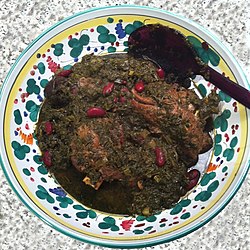Ghormeh sabzi
 | |
| Alternative names | Qormeh sabzi |
|---|---|
| Type | Stew |
| Place of origin | |
| Main ingredients | Herbs (parsley, leeks or green onions, cilantro, dried fenugreek leaves) |
Ghormeh sabzi (Template:Lang-fa; also spelled as qormeh sabzi) is an Iranian herb stew. It is a very popular dish in Iran.[1]
Etymology
Ghormeh is derived from Turkic kavurmak and means "braised," while sabzi is the Persian word for herbs.[2]
History of Ghormeh Sabzi stew in Iran
Perhaps the history of this stew in Iran goes back to nomadic life. Of course, we can not say anything explicit about this. Because some other sources consider the presence of vegetables and rice together as a reason to say that the main origin of this delicious stew was the northern green belt of Iran. For example, in Gilan province. However, people living in different geographical areas have used different combinations of different types of vegetables to cook this stew. This selection of different vegetables has caused the vegetable stew to have different flavors and tastes in different geographical areas. For example, Bakhtiari or Azerbaijani nomads use a kind of vegetable and mountain leek with a lot of onions and gourd or lemon in cooking vegetables. Besides, people living in the city of Shiraz prepare ready-made vegetables with vegetables such as coriander and spinach in abundance. They cooked potatoes.[3]
Preparation

The main ingredients are a mixture of sauteed herbs, consisting mainly of parsley, leeks or green onions, and coriander, seasoned with the key spice of dried fenugreek leaves. The herb mixture has many variations. Any dark bitter greens can be used, such as kale, mustard greens, turnip greens, etc., although none are part of the original recipe.[4]
This mixture is cooked with kidney beans or yellow split-peas, yellow or red onions, black lime (pierced dried limu-Omani Persian lime), and turmeric-seasoned lamb or beef. The dish is then served with chelow (Persian parboiled and steamed rice) or over tahdig.[5] Vegetarian ghormeh sabzi may substitute whole walnut pieces or mushrooms for the meat.[6]
International Ghormeh Sabzi Day
The last Saturday of each November (First Shanbeh of the Month of Azar in Solar-Hijri Calendar) was declared as the International Ghorme Sabzi day (Persian: روز جهانی قرمه سبزی) by Iranian expats to familiarize people of different cultures with Iranian cuisine and history. This unofficial holiday is usually two days after Thanksgiving Day in the United States.[citation needed]
See also
References
- ^ Dana-Haeri, Jila; Ghorashian, Shahrzad; Lowe, Jason (2011). New Persian Cooking: A Fresh Approach to the Classic Cuisine of Iran. I.B.Tauris. p. 79. ISBN 978-1848855861.
- ^ Gur, Janna (2014). "Ghormeh Sabzi - Beef and Herb Stew". Jewish Soul Food: From Minsk to Marrakesh, More Than 100 Unforgettable Dishes Updated for Today's Kitchen. Knopf Doubleday Publishing Group. pp. 1–240. ISBN 978-0805243093.
Ghormeh in Persian means "stew," of which there are quite a lot in Persian cuisine. Sabzi means "herbs" and sometimes refers to the fresh herbs that accompany a traditional meal.
- ^ https://food.7b.vc/history-of-ghormeh-sabzi-in-iranian-ancient-history/
- ^ Ghormeh Sabzi – Persian Herb Stew
- ^ Iran: Ghormeh Sabzi
- ^ "Ghormeh Sabzi -Blog | Persian Food-Termeh Travel". Termeh Blog. 2019-06-02. Retrieved 2019-06-23.
